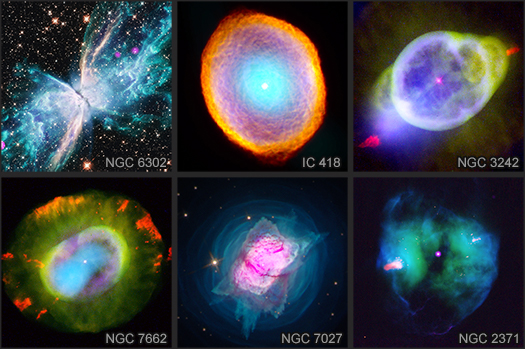Planetary Nebula: Misnamed But Not Misunderstood

Planetary Nebulas: NGC 6302, IC 418, NGC 3242, NGC 7662, NGC 7027, and NGC 2371.
Credit: X-ray: NASA/CXC/RIT/SAO/J.Kastner; Optical: NASA/ESA/AURA/STScI/Univ. Washington, B.Balick
Sometimes the names of objects are deeply misleading. For example, starfish are not actually fish (they are echinoderms) and guinea pigs are not related to pigs in any way (they are rodents). Similarly, planetary nebulas have nothing to do with planets. They were misnamed when scientists looking through small telescopes in the 19th century thought that these objects looked like planets.
Today, astronomers know that a planetary nebula actually represents a phase that stars like our Sun experience after they use up much of their fuel. After cooling and expanding through a “red giant” phase when it begins to expel its outer layers, such a star leaves behind a type of dense and smaller star called a white dwarf. The previously jettisoned shells of gas remain for a relatively short time in cosmic terms — tens of thousands of years — before dissipating into space. Meanwhile they are illuminated and energized by the white dwarf at the center of the system. This will happen to our Sun, but not for another 5 billion years or so.
NASA’s Chandra X-ray Observatory contributes to the understanding of planetary nebulas by studying the hottest and most energetic processes still at work in these beautiful objects. X-ray data from Chandra reveal winds being driven away from the white dwarf so quickly (i.e., millions of miles per hour) that they create shock waves during collisions with slower-moving material previously ejected by the star. Chandra’s exceptional vision in X-rays contributes to the understanding of this brief, yet important, stage of stars’ lives.
This gallery contains a half a dozen planetary nebulas that have been observed both by Chandra and NASA’s Hubble Space Telescope, with the latter detecting the delicate-looking structures of gas that have been expelled from the star. The colors of the Chandra data in the six planetary nebulas have been selected so that the X-rays are clearly distinct from the optical data. The list of planetary nebulas and the colors used for the Chandra data are as follows: NGC 6302 (magenta), IC 418 (cyan), NGC 3242 (blue), NGC 7662 (blue), NGC 7027 (magenta), and NGC 2371 (purple). The planetary nebulas range in distances from about 2,200 to 5,700 light years from Earth.
While all six nebulas originated from similar physical conditions and evolved by similar processes, they currently appear somewhat different from others. The differences in the shapes and structures of these planetary nebulas may be due to the complexities of a slew of physical properties including how much of the star’s winds flow from its poles, whether the star wobbles (or “precesses”) as it spins, if the star has a companion or not, and other factors.
NASA's Marshall Space Flight Center manages the Chandra program. The Smithsonian Astrophysical Observatory's Chandra X-ray Center controls science from Cambridge Massachusetts and flight operations from Burlington, Massachusetts.
